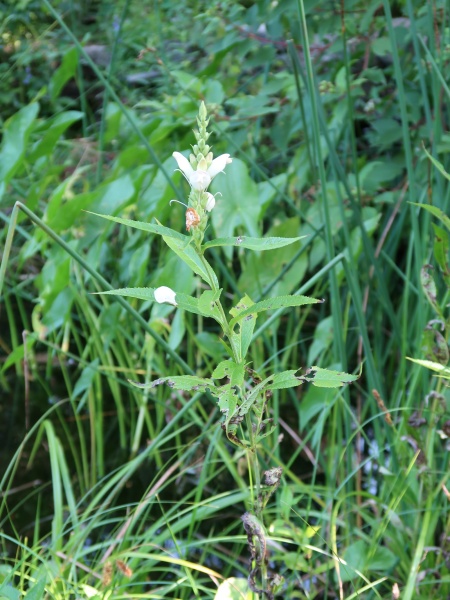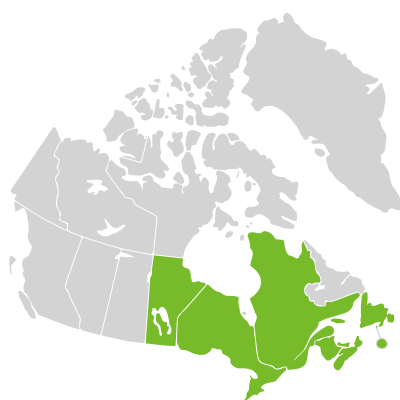 Known to be toxic - Toxic if ingested (can cause mild GI upset).
Known to be toxic - Toxic if ingested (can cause mild GI upset).

Source: OWSL
Chelone glabra
White Turtlehead
Galane glabre
Synonyms
snakehead
Seeds in stock
Available at table Full sun
Available at table Full sun
We currently accept seeds for this plant
Bloom Colour: White
Bloom Period: Aug - Oct
Max Height: 5.0 feet
Max Width: 3.0 feet (spreads by rhizome)
Light Condition:
 More than 6 hours of direct sun a day
Soil conditions:
More than 6 hours of direct sun a day
Soil conditions:
 Tolerates wet soil condition
Tolerates wet soil condition
 More than 6 hours of direct sun a day
More than 6 hours of direct sun a day
 Tolerates wet soil condition
Tolerates wet soil condition
Lifespan:
Perennial
plants that will that come back year after year
Gardener Experience:
 Suitable for beginner gardeners
Suitable for beginner gardeners
 Does not spread uncontrollably
Does not spread uncontrollably
 Suitable for beginner gardeners
Suitable for beginner gardeners
 Does not spread uncontrollably
Does not spread uncontrollably
Landscape Uses:
 Suitable for rain gardens
Suitable for rain gardens
 Suitable for shoreline rehabilitation
Suitable for shoreline rehabilitation
 Suitable for school gardens
Suitable for school gardens
 Suitable for rain gardens
Suitable for rain gardens
 Suitable for shoreline rehabilitation
Suitable for shoreline rehabilitation
 Suitable for school gardens
Suitable for school gardens
Ecological Benefits:
No ecological benefits information available.
Tolerates:
 Deer resistant
Deer resistant
 Rabbit resistant
Rabbit resistant
 Tolerates foot traffic around the plant
Tolerates foot traffic around the plant
 Tolerates limestone conditions
Tolerates limestone conditions
 Tolerates juglone conditions
Tolerates juglone conditions
 Tolerates transplantation
Tolerates transplantation
 Deer resistant
Deer resistant
 Rabbit resistant
Rabbit resistant
 Tolerates foot traffic around the plant
Tolerates foot traffic around the plant
 Tolerates limestone conditions
Tolerates limestone conditions
 Tolerates juglone conditions
Tolerates juglone conditions
 Tolerates transplantation
Tolerates transplantation
Special Features and Considerations:
Plant Location
Native to Ottawa region: Yes
Distribution according to VASCAN

Ephemeral
Native
Introduced
Excluded
Extirpated
Doubtful
Absent
Thrives in Ecozones
- Atlantic Maritime
- Boreal Plains
- Boreal Shield
- Mixed Wood Plains
Ecological Benefits
Butterflies Supported by Chelone glabra
- Euphydryas phaeton (Baltimore Checkerspot)
Specialized Bees Supported by Chelone glabra
No bee data available for this plant.
Plants that grow in similar conditions, that bloom at the same time.
Complementary Plants
- Gentiana andrewsii
Closed Bottle Gentian
Gentiane d'Andrews - Geum rivale
Water Avens
Benoîte des ruisseaux - Iris versicolor
Harlequin Blue Flag Iris
Iris versicolore - Scirpus pendulus
Hanging Bulrush
Scirpe pendant - Scutellaria lateriflora
Mad-dog Skullcap
Scutellaire latériflore
Substitute For Non-Native Plants
- Butomus umbellatus (Flowering Rush)
- Iris pseudacorus (Yellow Iris)
- Iris (Iris Cultivars)
Sowing Information
Download Seed Envelope Labels (PDF)
- Sowing depth: Sow just below surface
- Sow by January
- Stratification duration: 90 days
Harvesting and Seed Sharing
- Harvest start month: November
- Harvesting indicator:
- Pods are brown and slightly open
- Harvesting:
- Cut stem (including pods), let air dry in paper bag, then shake seeds off after a few days
- Seed viability test:
- No test needed before donating
- Packaging measure: 1 rounded 1/8 teaspoon
- Seed storage:
- Air dry in paper bag or open container, for a few days until crisp
- Shake seeds to move them once in a while to prevent molding
- Cultivar: Yes, do not donate unless you know source, and there are no known cultivars in your garden or at proximity
- Remove non-seed material
- Harvesting video: Watch here
Toxicity Notes
Toxic if ingested (can cause mild GI upset).


 Canadensis
Canadensis
